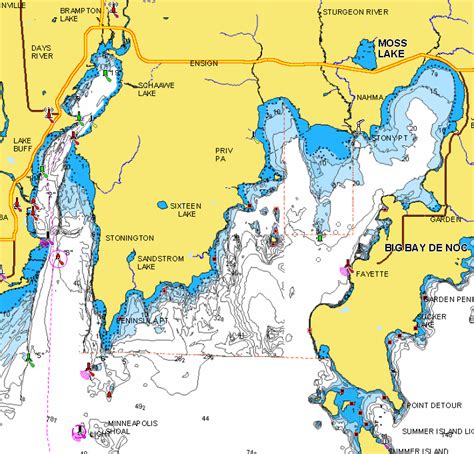Nestled along the southern shore of Michigan’s Upper Peninsula, Bay de Noc is a vast freshwater bay renowned for its unspoiled beauty, rich history, and diverse recreational opportunities. Spanning over 300 square miles, the bay is dotted with picturesque islands, sheltered harbors, and miles of pristine coastline.

A Haven for Nature Lovers
Bay de Noc is a paradise for nature enthusiasts, offering a sanctuary for a wide variety of plant and animal species. The bay’s shallow waters, extensive wetlands, and lush forests support a thriving ecosystem, including:
-
Over 200 bird species: Bay de Noc is a designated Important Bird Area by Audubon, hosting migratory waterfowl, bald eagles, and other birds of prey.
-
Abundant fish populations: The bay’s nutrient-rich waters teem with various fish species, including walleye, smallmouth bass, perch, and northern pike.
-
Vibrant plant life: The bay’s wetlands and coastal areas host a diverse array of aquatic and terrestrial plants, creating a mosaic of vibrant colors and textures.
A Rich Historical Tapestry
Bay de Noc has played a vital role in the history of the Upper Peninsula. Native American tribes, including the Ojibwe and Ottawa, inhabited the area for centuries, using the bay for fishing, hunting, and transportation. In the 17th century, French fur traders established trading posts along the bay, paving the way for European settlement.
Over time, Bay de Noc became a center of commerce and industry, with logging, mining, and shipbuilding serving as key economic sectors. The bay’s deep-water ports facilitated the transportation of goods and materials, contributing to the growth of the region.
A Destination for Recreation
Bay de Noc offers a wide range of recreational activities for visitors of all ages. Whether you’re seeking solitude in nature or engaging in thrilling adventures, the bay has something to offer:
Fishing: The bay’s abundant fish populations provide ample opportunities for both recreational and commercial fishing. Charter boats and guided tours are available for a memorable fishing experience.
Boating: Bay de Noc is a boater’s paradise, with calm waters, sheltered harbors, and miles of scenic coastline to explore. Kayaking, canoeing, and paddleboarding are also popular ways to experience the bay’s tranquility.
Hiking and Biking: The bay’s surrounding forests and coastal trails offer a variety of hiking and biking opportunities, ranging from short nature walks to challenging backcountry treks.
Camping: Bay de Noc has several designated campsites along its shores, providing a chance to immerse yourself in the beauty of the great outdoors.
Wildlife Viewing: Birdwatching, wildlife photography, and even bear watching are popular activities in Bay de Noc, where sightings of bald eagles, deer, and other wildlife are common.
Economic Impact
Bay de Noc is a vital economic driver for the surrounding communities. The bay’s rich natural resources, coupled with its scenic beauty, support a thriving tourism industry. Recreation, fishing, and wildlife viewing generate significant revenue for local businesses.
In addition, the bay’s deep-water ports facilitate the import and export of goods, contributing to the region’s industrial and commercial activities. The bay’s proximity to major cities and transportation hubs further enhances its economic importance.
Challenges and Opportunities
Like many natural resources, Bay de Noc faces several challenges, including:
Environmental degradation: Pollution from industrial activities, wastewater discharge, and invasive species can threaten the bay’s delicate ecosystem.
Development pressure: The increasing popularity of Bay de Noc as a destination for recreation and tourism can lead to unsustainable development and strain its natural resources.
Climate change: Rising water levels and more frequent storms can impact the bay’s shoreline communities and sensitive habitats.
These challenges present opportunities for innovation and responsible stewardship. By implementing sustainable practices, protecting water quality, and mitigating the impacts of climate change, Bay de Noc can remain a pristine and vibrant natural resource for generations to come.
Data and Statistics
-
According to the Michigan Department of Natural Resources, Bay de Noc’s commercial fishing industry generates over $1 million annually.
-
The bay’s tourism industry contributes approximately $50 million to the local economy each year.
-
Bay de Noc is home to over 500 species of aquatic plants, including wild rice, arrowhead, and water lilies.
-
The bay’s wetlands provide critical spawning and nursery habitat for numerous fish species, including walleye, yellow perch, and northern pike.
Customer-Centric Approaches
Understanding the wants and needs of Bay de Noc’s customers is crucial for its sustainable management and development. By addressing their pain points and motivations, organizations and policymakers can create strategies that enhance the bay’s enjoyment and preservation:
Pain Points:
- Overcrowding during peak season
- Limited access to certain areas
- Degradation of natural resources
Motivations:
- Connecting with nature
- Experiencing recreational activities
- Preserving the environment for future generations
Effective Strategies
To address these pain points and capitalize on customer motivations, effective strategies include:
- Expanding recreational opportunities and infrastructure while ensuring sustainable practices
- Implementing zoning regulations to mitigate overcrowding and protect sensitive areas
- Engaging the public in conservation efforts and promoting responsible tourism
- Investing in research and monitoring programs to assess the bay’s health and identify emerging challenges
Conclusion
Bay de Noc is a natural treasure that offers an abundance of recreational, economic, and ecological benefits. By addressing its challenges through innovation and responsible stewardship, we can ensure that future generations can continue to enjoy the pristine beauty and vital resources this bay provides. Bay de Noc serves as a reminder of the importance of preserving our natural heritage for generations to come.
